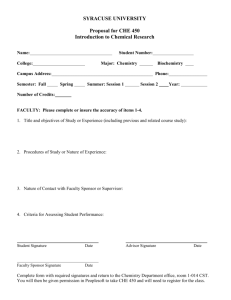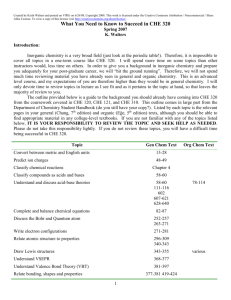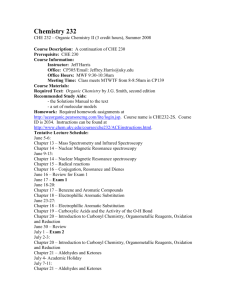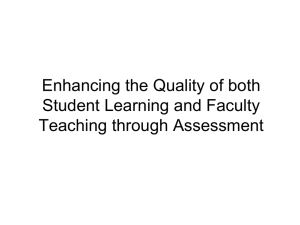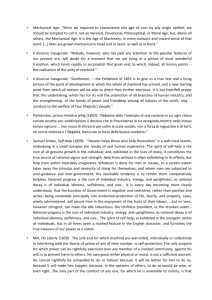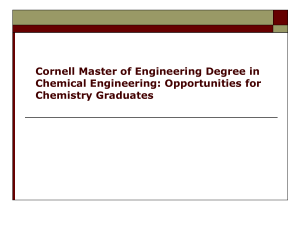Chemistry example - University of Kentucky
advertisement
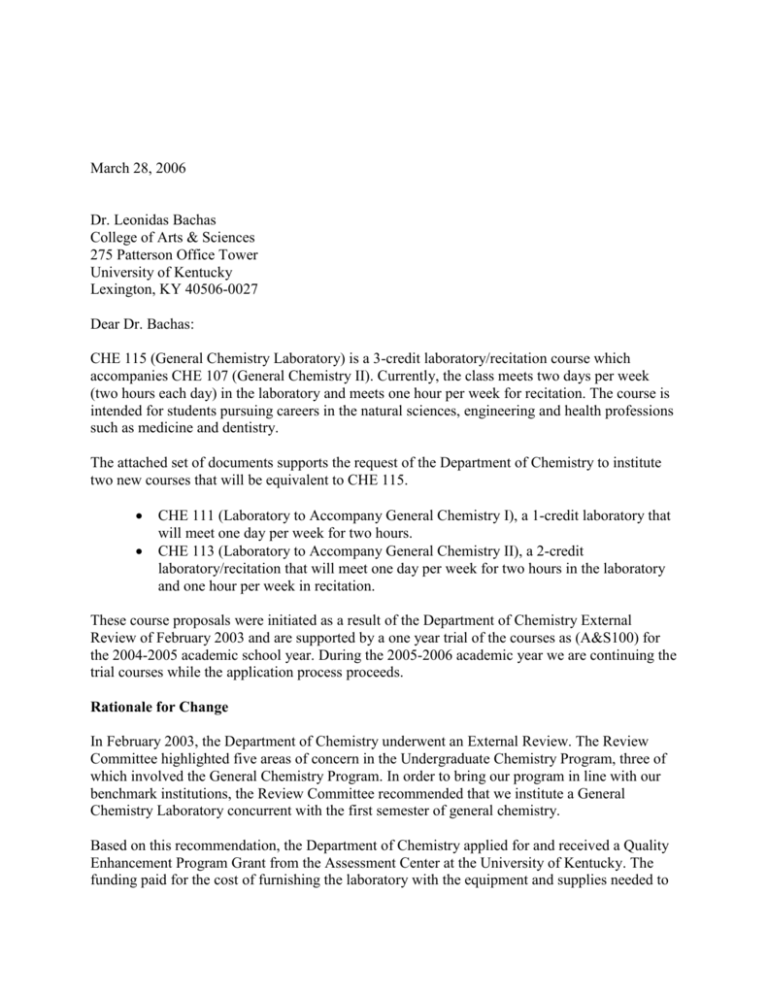
March 28, 2006 Dr. Leonidas Bachas College of Arts & Sciences 275 Patterson Office Tower University of Kentucky Lexington, KY 40506-0027 Dear Dr. Bachas: CHE 115 (General Chemistry Laboratory) is a 3-credit laboratory/recitation course which accompanies CHE 107 (General Chemistry II). Currently, the class meets two days per week (two hours each day) in the laboratory and meets one hour per week for recitation. The course is intended for students pursuing careers in the natural sciences, engineering and health professions such as medicine and dentistry. The attached set of documents supports the request of the Department of Chemistry to institute two new courses that will be equivalent to CHE 115. CHE 111 (Laboratory to Accompany General Chemistry I), a 1-credit laboratory that will meet one day per week for two hours. CHE 113 (Laboratory to Accompany General Chemistry II), a 2-credit laboratory/recitation that will meet one day per week for two hours in the laboratory and one hour per week in recitation. These course proposals were initiated as a result of the Department of Chemistry External Review of February 2003 and are supported by a one year trial of the courses as (A&S100) for the 2004-2005 academic school year. During the 2005-2006 academic year we are continuing the trial courses while the application process proceeds. Rationale for Change In February 2003, the Department of Chemistry underwent an External Review. The Review Committee highlighted five areas of concern in the Undergraduate Chemistry Program, three of which involved the General Chemistry Program. In order to bring our program in line with our benchmark institutions, the Review Committee recommended that we institute a General Chemistry Laboratory concurrent with the first semester of general chemistry. Based on this recommendation, the Department of Chemistry applied for and received a Quality Enhancement Program Grant from the Assessment Center at the University of Kentucky. The funding paid for the cost of furnishing the laboratory with the equipment and supplies needed to make the change and to determine whether the change would indeed have a positive impact on CHE 105 (General Chemistry I) student performance. Students in the experimental courses showed marked improvement in multiple areas as shown in the summary presented in the tables on the following pages. The data clearly support the proposed changes in the General Chemistry laboratory program. Note that the number of students participating in each category in the study is indicated in the tables by the variable n. In both CHE 105 and CHE 107, the numbers show a decline in the DEW rate when students participate in the laboratory. Furthermore, there is a significant increase in the number of students receiving A and B’s in CHE 105 and CHE 107 when they participate simultaneously in the laboratory. Such participation appears to assist average students to excel in the courses. Grade Breakdown (CHE105 FALL 2004) Category (% of grade) Total CHE105 Students*** (n=1560) CHE105 Students in Lab (n=70) Exam 1 (20%) 70% 73% Exam 2 (20%) 76% 78% Exam 3 (20%) 68% 71% Final (25%) 72% 72%* HW Average (10%)** 68% 77% Class Participation (5%)** 81% 84% Average Math ACT 26.01 25.18 Note: Exam 3 and the Final were curved to receive the percentages in the table. * One student did not take the final examination; therefore n=69. ** Section 005 did not require class participation. For this section 15% of grade was based on the homework grade. *** Grades of students participating in the laboratory were not removed in these calculations. The effect of this action is minimal because n is quite large relative to the number of students participating in the laboratory. Category Total Percentage Points Earned GPA for course %A %B %C %D %E %W Category (% of grade) Exam 1 (20%) Exam 2 (20%) Exam 3 (20%) Final (25%) HW Average (10%) Class Participation (5%) Summary of Grade (CHE105 FALL 2004) All CHE105 Students (n=1560) CHE105 Students in Lab (n=70) 74.6% 77.1% 2.17 2.32 16.5% 20.8% 20.7% 22.2% 19.0% 15.3% 13.9% 13.9% 12.4% 13.9% 8.8% 5.6% Grade Breakdown (CHE107 SPRING 2005) CHE107 /A&S100 CHE107 /CHE115 CHE107/ (n=38) (n=496) No Laboratory (n=345) 71% 72% 65% 70% 71% 63% 69% 72% 64% 67% 71% 63% 77% 78% 60% 72% 79% 57% Category Summary of Grade (CHE107 SPRING 2005) CHE107 /A&S100 CHE107 /CHE115 Total Percentage Points Earned %A %B %C %D %E %W 73.3% 21% 26% 13% 11% 21% 11% 75.8% 23% 20% 22% 13% 14% 8% CHE107 / No Laboratory 66.0% 5% 15% 20% 13% 24% 24% Advantages and Disadvantages There are a number of advantages to offering these two parallel laboratory courses relative to a single one-semester laboratory course (CHE 115). The first and most compelling advantage of the first-semester parallel laboratory is the hands-on experience with chemicals and apparatus by students. Chemistry is broadly defined as the study of matter and the changes it undergoes. By denying students direct experience with matter and its changes, we negate one of the primary pedagogical advantages of the laboratory sciences. A first-semester of chemistry with no laboratory becomes a theoretical experience and experimental science is a mere abstraction. With the additional attention to the subject provided in the first semester, our data show an increase in student success rate as indicated by the percentage of A, B, and C grades earned in CHE 105. The rather large statistical uncertainty in the data preclude assigning a high level of significance to the results, but the trend is certainly in the direction of higher achievement. Our primary objective is improvement in student learning and success. The data for CHE 107 clearly demonstrate that students who enroll in a concurrent laboratory (A&S 100 or CHE 115) perform significantly better than those who are not enrolled in a laboratory. These results are quite significant statistically in spite of the rather large uncertainty of the data. Requiring CHE 107 students to enroll in CHE 115 lab in its current 3-credit format represents a heavy load for some students in a single subject during the spring semester of their freshman year. Currently, CHE 115 students perform experiments that reinforce topics covered in both CHE 105 and CHE 107 lectures. By dividing the laboratory, there is a more realistic and balanced load placed on students, and the topics covered in the laboratory reinforce concepts covered in the lecture in real time, not after the fact. The change will eventually balance out the teaching loads of our graduate assistants. Currently, the vast majority of students enroll in CHE 115 during the spring semester, concurrent with CHE 107. The large number of students causes a serious imbalance in our teaching load. In addition, several of our advanced laboratories are offered in spring semester only, which further exacerbates this problem. By instituting the two-semester CHE 111/CHE 113 laboratory sequence, we will be able to utilize our resources much more effectively by balancing the number of TAs in the fall and spring semesters. We anticipate that no additional teaching assistants will be needed except during the period in which the transition is made from the one-semester to the two-semester laboratory. We believe that the rationale for instituting the two-semester laboratory program in General Chemistry is compelling. Our evidence suggests that this change will improve student learning and performance and that departmental resources will be utilized more efficiently and effectively. We respectfully request that you review and approve the pair of proposals submitted. If you have any questions or need further information, please contact us. Sincerely, Kim Woodrum Director of General Chemistry /jec Carolyn P. Brock Director of Undergraduate Studies
